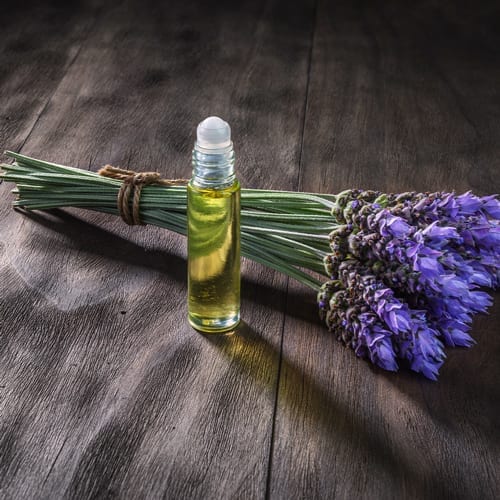
The most common type of headache that afflicts most people are tension headaches. A tension-type headache affects over one-third of men and over one-half of women in the world. The most common way to relieve headache pain is to use over the counter painkillers. Although oral painkillers have their uses, taking to many of them leads to unpleasant side effects.
Chronic use of acetaminophen (such as Tylenol) can cause nausea, rash, liver damage (with high doses). Nonsteroidal anti-inflammatory drugs (such as Advil) can cause stomach upset, heartburn, and stomach ulcers and kidney problems (with long-term use). The next time you feel an oncoming headache, consult your essential oil collection for relief. There are several essential oils known to help relieve tension and alleviate pain. When used together, they offer a natural way to treat headaches.
Magnesium oil is the carrier oil in this blend. You can either make your own magnesium oil or you can purchase ready-made magnesium oil. The magnesium can help alleviate headaches (especially if you are magnesium deficient). Peppermint provides a cooling element, lavender is for calming, cinnamon is for pain relief, and frankincense is for healing. This quick recipe is easy to whip up in minutes.
Ingredients:
- 10 drops Peppermint Essential Oil
- 10 drops Lavender Essential Oil
- 10 drops Cinnamon Essential Oil
- 5 drops Frankincense Essential Oil
- Magnesium Oil
- Roll on bottle
- Pipette
- Extra jar for mixing
How it’s done:
- Add the essential oils to the spare jar first, then add in a couple pipettes of magnesium oil. Swirl the jar to mix the oils, then add to the roll-on bottle.
- Fill the roll-on bottle with additional magnesium oil until it almost reaches the top.
- Place on the roller top and you’re done!
To use: simply roll onto to shoulders and neck when you feel the onset of a headache. Make a few extra bottles of the headache relief stick to always have on hand. Store the bottles in a cool, dry place out of direct sunlight.
Let’s take a closer look at how the ingredients work in this effective home remedy.
Peppermint Essential Oil
Researchers have been studying the benefits of peppermint oil for treating headaches for decades now, including a 2015 review published in the Asian Pacific Journal of Tropical Biomedicine which reported that peppermint oil may be effective for eliminating headaches. It may be due to the active ingredient in peppermint oil known as menthol. Nearly half of the oil is made up of menthol, which is known to lessen the intensity of acute migraine. Research published in Frontiers in Neurology found that using a topical gel with 6 percent menthol on those who were suffering from migraines resulted in decreased pain intensity after two hours.
Peppermint oil has a long-lasting, cooling effect on the skin. It helps to stimulate blood flow in the forehead and also inhibit muscle contractions. It’s also been found to be effective for other symptoms that tension, sinus, cluster headaches and migraines can cause such as nausea, congestion and muscle pain.
Lavender Essential Oil
Lavender essential oil is well-known for its many therapeutic properties, but it’s perhaps most famous for its ability to relax, relieve stress and tension. It offers sedative, anti-anxiety, and antidepressant properties, among others, that can help ease the pain of a headache, especially when related to anxiety or stress. It’s been found to aid in regulating serotonin levels, which helps to lessen nervous system pain that can lead to a migraine attack.
Multiple studies have confirmed lavender’s beneficial effects in managing migraines, including 2012 research from the Department of Neurology at Iran’s Mashhad University of Medical Sciences. When compared to a placebo, there was a significant difference in the severity of headache symptoms in volunteers who inhaled lavender oil for 15 minutes during a migraine attack, with the majority responding positively, with symptoms either entirely or partially diminished.
Cinnamon Essential Oil
Cinnamon essential oil is especially popular for its spicy-sweet flavor and alluring aroma, but it’s also known to provide many therapeutic benefits. The phenols in cinnamon leaves are what gives it so many health-promoting qualities. It contains 80 percent phenols, mainly eugenol, which provides anesthetic, antiseptic, antimicrobial, and antioxidant properties. These compounds aid in triggering the production of neurotransmitters like serotonin and dopamine, which helps to balance brain chemicals, ease symptoms of anxiety, stress, tension, nervousness, and depression. As they also work to increase circulation by expanding blood vessels, it can reduce or eliminate headache pain too.
Frankincense Essential Oil
Frankincense is one of the most commonly used essential oils, containing over 200 molecular compounds that give it its complex bouquet, as well as a wide range of medicinal properties. It contains a significant amount of soothing compounds called boswellic acids, and many therapeutic properties that are attributed to it as an antiseptic, disinfectant, astringent, carminative, cicatrisant, cytophylactic, digestive, diuretic, expectorant, sedative, tonic, uterine and vulnerary substance among others, that make it particularly good for fighting stress and tension.
The powerful effects of this essential oil for treating headaches specifically is believed to be due to a collection of compounds referred to as monoterpenes. In a research paper titled A Review on Anti-Inflammatory Activity of Monoterpenes, the experts discuss the anti-inflammatory activity of 32 bioactive monoterpenes found in essential oils noting many offer potent anti-inflammatory properties that, similar to conventional painkillers, reduce the swelling of blood vessels that initiate the chain reaction that leads to pain.
Magnesium and Headaches
Magnesium is an important mineral, yet many if not most Americans don’t get enough of this nutrient. Some reports have estimated that as many as 80 percent of American adults are lacking magnesium. As it’s utilized by every organ in the body, without enough magnesium it can result in all sorts of problems, including fatigue, mild nausea, cramps and headaches or migraines. Numerous studies, including 1996 research that found magnesium reduced the frequency of migraine attacks by 41.6 percent, have shown that migraine sufferers typically have a low level of magnesium.
A May 2012 paper from the New York Headache Center concluded that as “magnesium deficiency may be present in up to half of the migraine patients, and that routine blood tests are not indicative of magnesium status, empiric treatment with at least oral magnesium is warranted in all migraine sufferers.” Drs. Mauskop and Varughese outlined multiple ways magnesium interacts with a migraine, noting that a magnesium deficiency may promote cortical spreading depression, cause blood vessels to constrict, affect serotonin (a key component related to a migraine), and influence various neurotransmitters.
7 More Home Remedies For Headaches
Here are more ways to stop a headache in its tracks using natural methods.
1. Eucalyptus Essential Oil
Other essential oils can be used as a home remedy for headaches too. If you have a sinus headache, eucalyptus oil is ideal as it offers expectorant properties which are known to help detox the body, eliminating harmful organisms and toxins while also eliminating sinus pressure and helping to open up nasal airways. A 2013 clinical trial found that inhaling eucalyptus oil was able to lessen pain and reduce blood pressure. It was also shown to promote emotional stability and provide potent anti-inflammatory properties that are beneficial for treating tension headaches.
Research from Israel also evaluated the efficacy of eucalyptus oil and reported that its anti-inflammatory effects, along with antiviral, antimicrobial and antibacterial compounds, helped to alleviate sinus pressure related to the inflammatory response and relieve sinus headaches.
To use it, dilute a few drops with a carrier oil like coconut oil and then apply it to your forehead, temples, back of your neck and chest.
2. Rosemary Essential Oil
Rosemary essential oil has been used in folk medicine for years in order to treat headaches and poor circulation thanks to its stimulating, analgesic and anti-inflammatory properties. It also helps to reduce emotional triggers that can lead to a headache while providing a calming effect. A study published in 2013 that evaluated the effects of rosemary essential oil effects on withdrawal symptoms, including headaches, found that the oil was effective for reducing pain and tension. You can use rosemary oil like you would the eucalyptus oil, by blending a few drops with a carrier oil like coconut oil and strategically applying to the forehead, temples, back of neck and chest.
3. Ginger Tea
Ginger is believed to help fight a migraine as it inhibits prostaglandin synthesis, which are lipid compounds that control the body’s response to inflammation, causing pain and increasing certain muscle contractions. It can also help diminish nausea that often accompanies migraines. Make a homemade ginger tea by simmering three slices (about the size of a quarter) of fresh ginger root in two cups of water, covered, for 30 minutes.
4. B Vitamins
Many of the B vitamins have a role in the formation of neurotransmitters like serotonin, which may be lacking in those who suffer from migraines. One Belgian study conducted in 1994 found that 59 percent of participants were able to slash their migraine frequency in half after taking 400 milligrams of B2, known as riboflavin, daily for three months. Supplement with Nature’s Way B2 Vitamin to help banish migraine headaches. B3 is also known for calming vascular headaches as it opens up the blood vessels to increase blood flow.
5. Sex
If you can manage to get in the mood for sex when you have a headache or a migraine, you may be able to get rid of it, if you can achieve orgasm, that is. In a 2013 study published in the journal Cephalalgia, almost half of migraine sufferers reported finding relief after having sex that resulted in orgasm. The experts say it’s likely because orgasm during sex releases endorphins, AKA “feel-good” hormones that are known to relieve pain.
6. Reflexology
A simple toe massage may be able to eliminate your headaches too. Reflexology is used in ancient Traditional Chinese Medicine, with certain points on the feet stimulated to encourage healing in corresponding parts of the body. You can go to a practitioner, or learn to use this ancient healing method on yourself, with multiple books on the subject.
For headaches, in particular, there are four pressure points for relieving them, on your feet and on your hand. Massage the area between your big toe and the second toe. If a headache is in your left temple, massage that point on your right foot and vice versa. To relieve a headache, you can also press the Tai Chong or Liver 3 point on the top of your foot. If you have pain on both sides of your head, massage both feet.
Near the outer edge of the top of the foot, where the bones of the pinky toe and the second to last toe intersect, is another pressure point for headache relief, particularly for those that run through the side of the head to the forehead. Press and hold the area for 30 to 60 seconds.
7. Keep Yourself Hydrated
By staying hydrated, drinking plenty of water, you can help keep headaches and migraines to a minimum as they’re more severe and more common when you’re dehydrated. In addition to water, sip an herbal tea like peppermint tea which will have kind of a “double whammy” effect thanks to its natural sedative properties that can help relieve stress and tension headaches.





